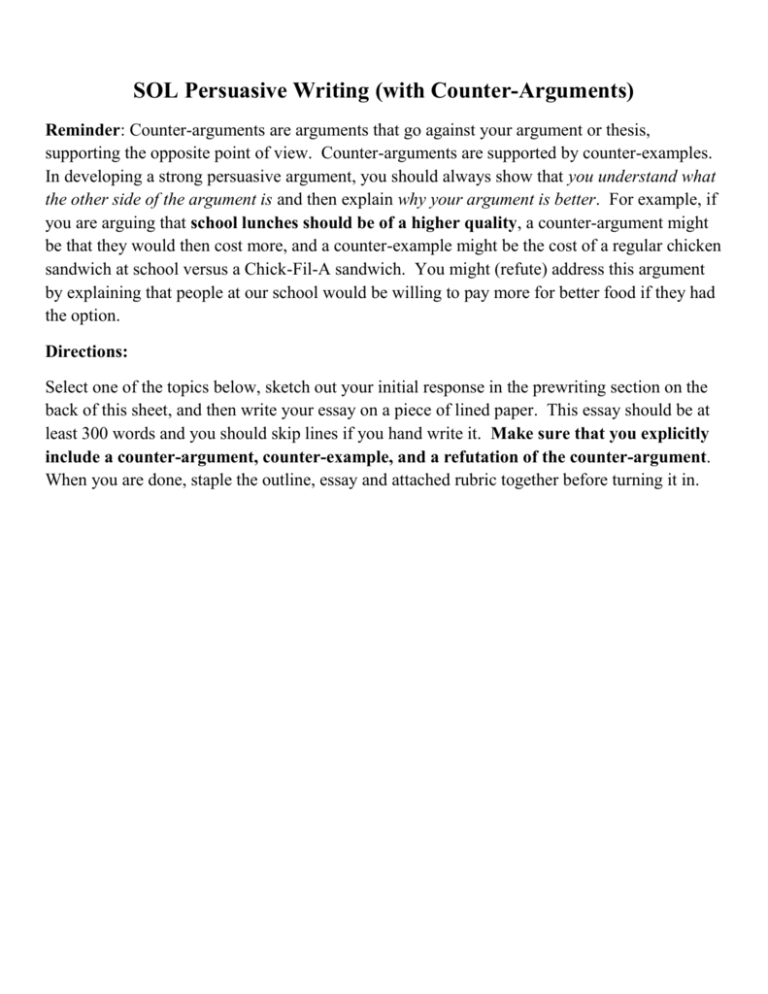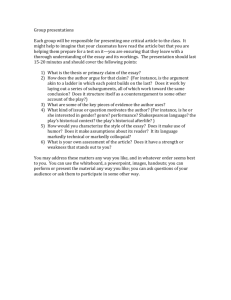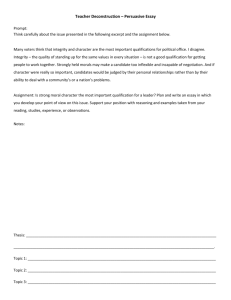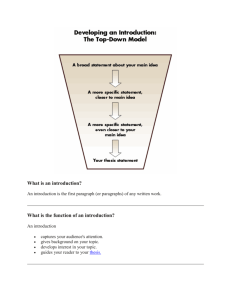with Counter
advertisement

SOL Persuasive Writing (with Counter-Arguments) Reminder: Counter-arguments are arguments that go against your argument or thesis, supporting the opposite point of view. Counter-arguments are supported by counter-examples. In developing a strong persuasive argument, you should always show that you understand what the other side of the argument is and then explain why your argument is better. For example, if you are arguing that school lunches should be of a higher quality, a counter-argument might be that they would then cost more, and a counter-example might be the cost of a regular chicken sandwich at school versus a Chick-Fil-A sandwich. You might (refute) address this argument by explaining that people at our school would be willing to pay more for better food if they had the option. Directions: Select one of the topics below, sketch out your initial response in the prewriting section on the back of this sheet, and then write your essay on a piece of lined paper. This essay should be at least 300 words and you should skip lines if you hand write it. Make sure that you explicitly include a counter-argument, counter-example, and a refutation of the counter-argument. When you are done, staple the outline, essay and attached rubric together before turning it in. Prewriting/Outline Thesis Statement (explain your position in 1-2 sentences) Supporting idea/premise 1: Example(s) Explanation of examples (how do they prove your point?) Supporting idea/premise 2: Example(s) Explanation of examples (how do they prove your point?) Supporting idea/premise 3: Example(s) Explanation of examples (how do they prove your point?) Counter-Argument summary Counter-example Explanation of counter-example: how does this illustrate the counter-argument? Refutation of counter-argument Conclusion (summarize thesis in fresh language) Rubric Category Does the essay/outline directly respond to all aspects of the prompt? Is the central idea fully supported with adequate and relevant details? Does the writer address an obvious counter-argument with logical evidence? Does the essay refute the counter-argument in a thorough and logical way? Does the essay demonstrate mastery of sentence structure? Does the essay demonstrate mastery of spelling, capitalization, punctuation or proofreading? Does the essay demonstrate mastery of grammar, mechanics, and usage conventions? Outline complete Thesis statement Mastery 10 Essay/outline clearly addresses all aspects of the prompt Central idea is supported with adequate and relevant details (at least 300 words) An obvious counterargument is explained clearly and supported with logical evidence The counter-argument is clearly, logically, and thoroughly addressed by the thesis and supporting evidence Essay effectively uses a variety of sentence structures Essay does not include any obvious errors in spelling, capitalization, punctuation or missing/extra words. No grammatical, mechanical or usage errors are apparent. Competent 8 Essay/outline generally addresses most aspects of the prompt Central idea is supported with some relevant details Emerging competence 6 Essay/outline marginally addresses some aspects of the prompt Central idea is supported with few relevant details Some counterargument is described and is either not clear or not well supported Vague counterargument is provided but does not reflect a clear understanding of the issues Some attempts are made at refuting the counterargument, though not convincing Essay uses a variety of sentence structures with no incomplete or run-on sentences. There is an average of 1 spelling, capitalization, punctuation or missing/extra words error per page There is an average of 1 grammatical, mechanical or usage error per page Outline is completed thoroughly and thoughtfully Thesis statement is clear, comprehensive and concise and draws the reader into the arguments in an engaging manner Little to no evidence of mastery 0 Essay/outline does not address the prompt Subtotal /10 Central idea is not supported with adequate and relevant details No meaningful counterargument is presented /10 No clear attempt is made at refuting the counter-argument /10 There is an average of 1-2 incomplete or run-on sentence per page There are an average of 2-3 spelling, capitalization, punctuation or missing/extra words errors per page There are an average of 2-3 grammatical, mechanical or usage error per page There are 3 or more incomplete or run-on sentences per page /10 There are an average of 4 or more spelling, capitalization, punctuation or missing/extra words errors per page There are an average of 4 or more grammatical, mechanical or usage error per page /10 Outline is mostly complete Outline is halfway complete Little to no elements of the outline are complete /10 Thesis statement is clear, comprehensive and concise Thesis statement is two of the following: clear, comprehensive and concise No thesis statement is evident. /10 The counter-argument is generally addressed by the thesis and supporting evidence Total /10 /10 /90









